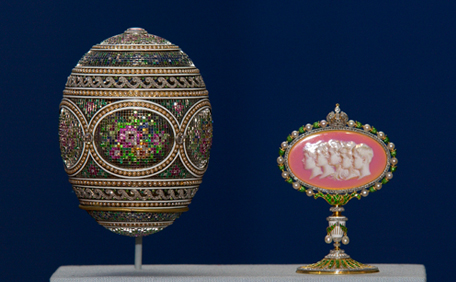What better way for a jewelry connoisseur to celebrate Easter than with a Fabergé Imperial Easter egg hunt?
Between 1885 and 1917, master jeweler Peter Carl Fabergé (1846 – 1920) and his staff of around 500 craftsmen created just 50 of his treasured eggs for the tsars of Russia as Easter gifts. The Romanovs, specifically the Russian Imperial Families of Alexander III (father) and Nicholas II (son), were spellbound by these artistic marvels, and Fabergé sought to make each new creation surpass the previous.
Fabergé’s imperial eggs often included the finest enamel work and each egg held a surprise objet d’ art hidden inside. The 1895 Rosebud Egg held a rosebud with individually enameled petals which in turn held a miniature crown (now lost) that could be worn as a pendant. Many times the surprise was a mechanical marvel as seen in the Peacock Egg of 1908: a mechanical peacock that when wound, it would strut, his head would move and his tail would fan out. Gold, diamonds, rubies, emeralds, sapphires, and other gemstones decorated the eggs, sometimes the eggs were carved out of gem material like rock crystal quartz, lapis lazuli and agate – but the astounding craftsmanship and artistry far exceeded the value of the materials.
Fabergé’s Imperial eggs, whether they were made for the Russian Imperial Family (the Romanovs) or for other wealthy clients, are scattered across the world in museums and private collections. We’ve made your Easter egg hunt easy by selecting some of our favorite ones.
An Art Nouveau-inspired masterpiece, the Lilies-of-the-Valley Egg (1898) was commissioned by Nicholas II for his wife Alexandra Federovna. It is covered in climbing stems of green enameled leaves over a pink guilloché enameled egg. Pearls are used to create delicate flowers that dangle from the stems. Rose-cut diamonds trickling down the legs of the base resemble morning dewdrops. Turn a pearl button to see the surprise: miniature portraits of Tsar Nicholas II and his two eldest children, Olga and Tatiana, appear from inside.
Pink diamonds, amethysts, and citrines comprise the bejeweled fruit decorating the 1911 Bay Tree Egg (formerly referred to as the Orange Tree Egg). Commissioned by Nicholas II, he gave it to his mother Maria Federovna, the Dowager Empress. White enamel with diamond hearts are the blossoms and the leaves are nephrite. The tree is in a square planter made out of white chalcedony with gold and green enamel swags accented with rubies all of which rests on a nephrite base. The hidden surprise: Push one of the oranges, and a bird emerges, piping a song to its flapping wings and clicking beak.
Important events in the life of Tsar Nicholas II and his family are depicted in the Fifteenth-Anniversary Fabergé Imperial Egg (1911). Presented to his wife the Empress Alexandra Federovna by Tsar Nicholas II, the large gold egg was commissioned to honor Nicholas II’s 15th anniversary as tsar. The surprise is not hidden in the egg but instead is exposed for everyone to see: the sixteen miniature paintings depict key events of Nicholas II’s reign as well as portraits of Nicholas II, Alexandra and their children, Olga, Tatiana, Maria, Anastasia and Alexei. The family portraits are framed with diamonds. Green enameled laurel leaves are the borders that separate the individual paintings.
Endless patience and remarkable skill were needed to make the Mosaic Egg (1914). Fabergé’s designer Alma Pihl was inspired by a petit-point design. The master craftsmen inlaid tiny diamonds, rubies, sapphires, emeralds, topazes, garnets, quartzes, and pearls into mesh made out of platinum to create a floral design. A diamond-framed pink enameled cameo of the children in profile is the surprise hidden inside; a fitting gift from the children’s father, Nicholas II to their mother, Alexandra.
Easter egg hunts end with delightful surprises, and such was the case with the Third Imperial Easter Egg (1887). In March 1964, not knowing that it was a Fabergé egg, it was sold as an objets d’art by Parke-Bernet Galleries in New York for $2,450. Recently, it was learned to be in the possession of an American, who bought it in the Midwest for $14,000 in the hope of making a quick profit by reselling it to a scrap metal trader. Unable to find a buyer, he did an internet search and discovered that he was in possession of a treasure that would eventually make him a millionaire. The surprise inside this egg: a Vacheron Constantin watch. The egg is now in a private collection.
There’s another lesson in the Third Fabergé Imperial Easter Egg: the value of design. The value of the raw materials that made up the egg seems small in comparison to the price that was paid for it. It was the artistry of master craftsmen that took these materials and turned them into something priceless. Such is the case with many fine and antique jewelry pieces.
The Fabergé imperial eggs may have been made as private treasures for the tsars, but now some of them are on public display at various museums around the world including the newly opened Fabergé Museum in St. Petersburg, Russia, the Kremlin Armoury Museum in Moscow, Virginia Museum of Fine Arts, Richmond, Virginia, Walters Art Gallery, Baltimore and Hillwood Museum in Washington, D.C. Also: be on the look-out for traveling exhibits.
Of the 50 eggs originally created for the Imperial Family, seven are still unaccounted for, so keep hunting: you never know where one might be hiding!




